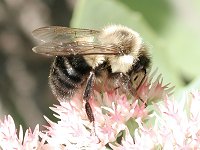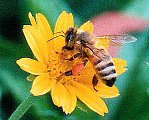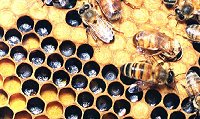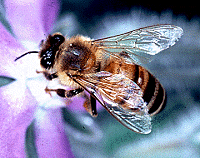 Bumble bee colonies have a relatively primitive social structure. They rarely contain more than few hundred workers and, other than size, there is usually little or no physical distinction between a queen and her workers. Caste determination appears to be based on food supply and the queen’s aggressive behavior. Bumble bees have no system for communicating information about food location to other members of the hive. Novice bees evidently learn to forage efficiently through a process of “trial and error”.
Bumble bee colonies have a relatively primitive social structure. They rarely contain more than few hundred workers and, other than size, there is usually little or no physical distinction between a queen and her workers. Caste determination appears to be based on food supply and the queen’s aggressive behavior. Bumble bees have no system for communicating information about food location to other members of the hive. Novice bees evidently learn to forage efficiently through a process of “trial and error”.
 Honey bees include the well-known European honey bee (Apis mellifera) as well as 8 other species of Apis that are native to Europe, Asia, and Africa. These bees usually nest above ground, often inside hollow trees. They construct vertical wax combs with individual hexagonal cells for storing honey and rearing brood. Each hive is “ruled” by a single queen whose only job is to lay eggs. Workers are adult females — daughters of the queen. They perform all housekeeping chores within the hive, search for nectar and pollen, produce wax and honey, feed the young and protect the hive against enemies. Adult workers live for about six weeks (during the summer) but queens may last for several years. During cold winters, the bees cluster together, feeding on stored food reserves and sharing their body heat.
Honey bees include the well-known European honey bee (Apis mellifera) as well as 8 other species of Apis that are native to Europe, Asia, and Africa. These bees usually nest above ground, often inside hollow trees. They construct vertical wax combs with individual hexagonal cells for storing honey and rearing brood. Each hive is “ruled” by a single queen whose only job is to lay eggs. Workers are adult females — daughters of the queen. They perform all housekeeping chores within the hive, search for nectar and pollen, produce wax and honey, feed the young and protect the hive against enemies. Adult workers live for about six weeks (during the summer) but queens may last for several years. During cold winters, the bees cluster together, feeding on stored food reserves and sharing their body heat.
Social caste is determined mostly by the diet an individual bee receives during larval development. Normally, workers feed their larvae royal jelly (a nutrient-rich glandular secretion) for the first few days and then switch to a less-nutritious diet of bee bread (a mixture of honey and pollen). Larvae destined to become queens, however, are reared in special (larger) brood cells and fed a diet of royal jelly throughout the entire duration of larval development. Males (drones) develop from unfertilized eggs. Their only function is to mate with virgin queens.
 A queen controls the social organization within her colony by means of a pheromone secreted from her mandibular glands. Workers lick this pheromone from the queen’s body and pass it to nestmates during the exchange of food (trophallaxis). Queen pheromone maintains tranquility within the hive and inhibits ovarian development among workers. When the queen dies (or fails to perform adequately), she is replaced by a new queen reared from within the hive. Each colony, therefore, has the potential to be perennial, that is, to endure beyond the lifespan of the founding queen and her workers. Mature, healthy colonies may grow to include as many as 80,000 workers. However, before they reach this size, most large bee hives will “reproduce” by swarming. This is a process of colony division in which an established queen leaves (absconds) with a large group of workers to establish a new nest site, while a young queen and the remaining workers stay behind to occupy the old nest site.
A queen controls the social organization within her colony by means of a pheromone secreted from her mandibular glands. Workers lick this pheromone from the queen’s body and pass it to nestmates during the exchange of food (trophallaxis). Queen pheromone maintains tranquility within the hive and inhibits ovarian development among workers. When the queen dies (or fails to perform adequately), she is replaced by a new queen reared from within the hive. Each colony, therefore, has the potential to be perennial, that is, to endure beyond the lifespan of the founding queen and her workers. Mature, healthy colonies may grow to include as many as 80,000 workers. However, before they reach this size, most large bee hives will “reproduce” by swarming. This is a process of colony division in which an established queen leaves (absconds) with a large group of workers to establish a new nest site, while a young queen and the remaining workers stay behind to occupy the old nest site.
 Bees represent a large and successful branch of the insect’s family tree: more than 20,000 species have been described worldwide. Nearly all of these species use pollen and/or nectar from flowering plants as food for themselves and their offspring. Physical adaptations for this lifestyle include branched (or plumose) body hairs for catching and holding pollen, combs (scopae) and baskets (corbiculae) for collecting and carrying the pollen, and tongue-like mouthparts for sipping nectar from flowers. Some bees collect nectar and then convert it into honey. This process occurs in the bee’s crop where sucrose in the nectar undergoes enzymatic conversion into glucose and fructose. The honey is regurgitated for storage or mixed with pollen and fed to developing larvae. Some bees have abdominal glands that secrete wax. This wax, alone or mixed with other substances, is often used for construction of the nest site.
Bees represent a large and successful branch of the insect’s family tree: more than 20,000 species have been described worldwide. Nearly all of these species use pollen and/or nectar from flowering plants as food for themselves and their offspring. Physical adaptations for this lifestyle include branched (or plumose) body hairs for catching and holding pollen, combs (scopae) and baskets (corbiculae) for collecting and carrying the pollen, and tongue-like mouthparts for sipping nectar from flowers. Some bees collect nectar and then convert it into honey. This process occurs in the bee’s crop where sucrose in the nectar undergoes enzymatic conversion into glucose and fructose. The honey is regurgitated for storage or mixed with pollen and fed to developing larvae. Some bees have abdominal glands that secrete wax. This wax, alone or mixed with other substances, is often used for construction of the nest site.
 Bumble bee colonies have a relatively primitive social structure. They rarely contain more than few hundred workers and, other than size, there is usually little or no physical distinction between a queen and her workers. Caste determination appears to be based on food supply and the queen’s aggressive behavior. Bumble bees have no system for communicating information about food location to other members of the hive. Novice bees evidently learn to forage efficiently through a process of “trial and error”.
Bumble bee colonies have a relatively primitive social structure. They rarely contain more than few hundred workers and, other than size, there is usually little or no physical distinction between a queen and her workers. Caste determination appears to be based on food supply and the queen’s aggressive behavior. Bumble bees have no system for communicating information about food location to other members of the hive. Novice bees evidently learn to forage efficiently through a process of “trial and error”. Honey bees include the well-known European honey bee (Apis mellifera) as well as 8 other species of Apis that are native to Europe, Asia, and Africa. These bees usually nest above ground, often inside hollow trees. They construct vertical wax combs with individual hexagonal cells for storing honey and rearing brood. Each hive is “ruled” by a single queen whose only job is to lay eggs. Workers are adult females — daughters of the queen. They perform all housekeeping chores within the hive, search for nectar and pollen, produce wax and honey, feed the young and protect the hive against enemies. Adult workers live for about six weeks (during the summer) but queens may last for several years. During cold winters, the bees cluster together, feeding on stored food reserves and sharing their body heat.
Honey bees include the well-known European honey bee (Apis mellifera) as well as 8 other species of Apis that are native to Europe, Asia, and Africa. These bees usually nest above ground, often inside hollow trees. They construct vertical wax combs with individual hexagonal cells for storing honey and rearing brood. Each hive is “ruled” by a single queen whose only job is to lay eggs. Workers are adult females — daughters of the queen. They perform all housekeeping chores within the hive, search for nectar and pollen, produce wax and honey, feed the young and protect the hive against enemies. Adult workers live for about six weeks (during the summer) but queens may last for several years. During cold winters, the bees cluster together, feeding on stored food reserves and sharing their body heat.
 Most species of stingless bees are relatively small (less than 1 cm in length) and live in colonies that contain one queen and 50-1000 workers. A few species, however, are as large as European honey bees and may have over 40,000 workers living together. Both queens and workers develop from fertilized eggs, but queen larvae have larger brood cells and receive more food than worker larvae. Males (drones) develop from unfertilized eggs (often laid by unmated workers). Most of the stingless bees form perennial colonies with the ability to replace the queen when she dies. Large colonies may divide by swarming, but workers usually build and provision a new nest before it will be occupied by a young queen and a group of workers from the old nest.
Most species of stingless bees are relatively small (less than 1 cm in length) and live in colonies that contain one queen and 50-1000 workers. A few species, however, are as large as European honey bees and may have over 40,000 workers living together. Both queens and workers develop from fertilized eggs, but queen larvae have larger brood cells and receive more food than worker larvae. Males (drones) develop from unfertilized eggs (often laid by unmated workers). Most of the stingless bees form perennial colonies with the ability to replace the queen when she dies. Large colonies may divide by swarming, but workers usually build and provision a new nest before it will be occupied by a young queen and a group of workers from the old nest. There is a wide range of social organization and communication among the species of stingless bees. Some produce low-frequency sound vibrations to alert nestmates to a new nectar source, others mark vegetation with an odor trail for recruits to follow, and still others enlist a group of foragers and guide them back to the food source. In tropical habitats, stingless bees have co-evolved with flowering plants since the Cretaceous period and these bees are now essential as pollinators for many native plants. Conservation efforts are needed to protect both the plants and the bees from habitat destruction.
There is a wide range of social organization and communication among the species of stingless bees. Some produce low-frequency sound vibrations to alert nestmates to a new nectar source, others mark vegetation with an odor trail for recruits to follow, and still others enlist a group of foragers and guide them back to the food source. In tropical habitats, stingless bees have co-evolved with flowering plants since the Cretaceous period and these bees are now essential as pollinators for many native plants. Conservation efforts are needed to protect both the plants and the bees from habitat destruction.